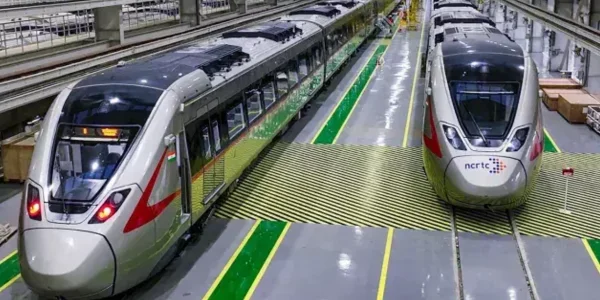In a significant leap for India’s transportation infrastructure, the Namo Bharat trains, operating on the Delhi–Meerut Regional Rapid Transit System (RRTS), have commenced services, drastically reducing travel time between Delhi and Meerut to approximately 40 minutes. This development marks a milestone in regional connectivity, promising to enhance economic integration and commuter convenience in the National Capital Region (NCR).
Project Overview
The Delhi–Meerut RRTS is an 82.15 km semi-high-speed rail corridor designed to facilitate swift transit between Delhi, Ghaziabad, and Meerut. The project, executed by the National Capital Region Transport Corporation (NCRTC), is being developed at an estimated cost of ₹30,274 crore. The corridor is expected to be fully operational by June 2025, with several sections already in service.
Namo Bharat Trains: Features and Specifications

The Namo Bharat trains, formerly known as RapidX, are engineered for speeds up to 180 km/h, with an operational speed of 160 km/h, making them the fastest rapid transit trains in India. Each six-coach trainset includes a premium coach and a dedicated coach for women, collectively accommodating up to 1,750 passengers. Manufactured under the ‘Make in India’ initiative by Alstom at their Savli plant in Gujarat, these trains boast modern amenities such as:
- Air-Conditioned Coaches: Ensuring passenger comfort across all seasons.
- On-Board Wi-Fi: Providing connectivity for commuters during transit.
- Ergonomic Seating: Designed for comfort during high-speed travel.
- Overhead Luggage Space: Facilitating convenient storage for personal belongings.
- Universal Accessibility: Features to accommodate passengers with reduced mobility.
Route and Stations
The RRTS corridor encompasses 16 stations, including key stops at Sarai Kale Khan, Anand Vihar, Ghaziabad, and Meerut South. The strategic placement of these stations aims to serve densely populated areas, thereby enhancing accessibility and reducing congestion on existing road networks. The integration with other modes of public transport, such as Delhi Metro and Indian Railways, ensures seamless commuter transfers, promoting a shift from private vehicles to public transit.
Fare Structure and Ticketing
The fare structure is designed to be competitive, encouraging widespread adoption among daily commuters. While exact fare details are subject to periodic revisions, the pricing strategy considers factors such as distance traveled and class of service, with options for both standard and premium seating. Ticketing options include:
- Digital QR Code-Based Tickets: Purchasable via the RapidX Connect mobile application.
- National Common Mobility Card (NCMC): Allowing seamless travel across various transit systems.
- Ticket Vending Machines (TVMs): Installed at stations for on-the-spot ticket purchases.
Operational Status and Future Expansions
As of now, the priority section between Sahibabad and Duhai Depot is operational, with subsequent sections slated to open progressively. The entire corridor is anticipated to be fully functional by mid-2025. Future plans include extending services to other regional nodes, enhancing the overall connectivity within the NCR.
Impact on Regional Mobility
The introduction of the Namo Bharat trains is poised to transform regional mobility by:
- Reducing Travel Time: Cutting the Delhi-Meerut journey to about 40 minutes.
- Decongesting Roads: Encouraging a modal shift from road to rail, alleviating traffic congestion.
- Environmental Benefits: Lowering carbon emissions through reduced vehicular traffic.
- Economic Growth: Stimulating economic activities by improving access to regional markets and employment hubs.
Conclusion
The operationalization of the Namo Bharat trains on the Delhi–Meerut RRTS corridor signifies a pivotal advancement in India’s transportation landscape. By offering high-speed, efficient, and comfortable travel options, it not only enhances commuter experience but also contributes to the broader goals of sustainable urban development and regional economic integration.
As the project progresses towards full completion, it sets a precedent for similar initiatives aimed at revolutionizing transit infrastructure across the nation.

